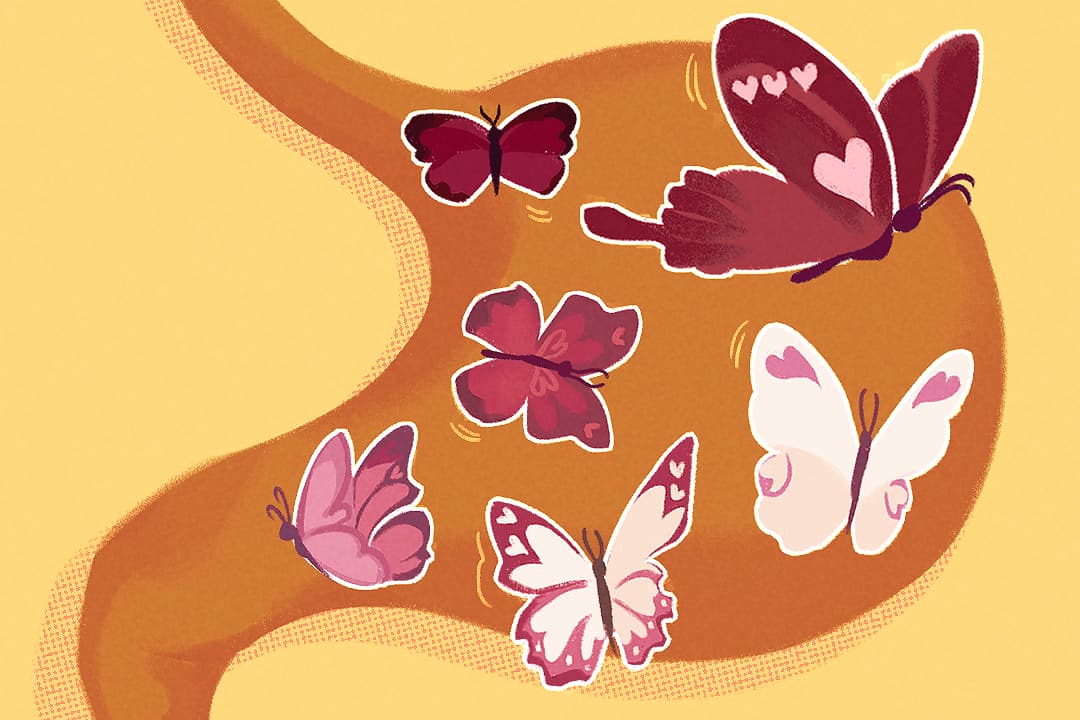Love can be an overwhelming, nauseating, but exhilarating journey, spanning from moments of nervousness in talking to your crush, to the spark of laughter from a playful joke. Sensations of butterflies — a sudden, joyful churn in the stomach — are probably a near-universal experience. They can arise in high-pressure scenarios like falling in love, as well as walking into the exam centre or eagerly anticipating a turn at karaoke.
Researchers have been investigating these “butterflies” and their origins for more than two decades. It turns out that a connection between our brain and gut holds the key to unravelling this enigma.
Our brains and gut communicate via the vagus nerve, a cranial nerve linking our thoughts and emotions to the sensations in our abdomen. Just as Pavlov’s dog salivated at the mere thought of food, our gut reacts to our thoughts and emotions in real-time.
So the phenomenon of butterflies in the stomach isn’t just a whimsical metaphor; it’s a complex interplay of biological processes set into motion by what scientists call our “gut-brain axis.” Within our gut reside a plethora of microbes that communicate with our central nervous system, ultimately shaping our thoughts, emotions, and behaviours.
The start of butterflies
According to a recent study, brain regions responsible for detecting stress signals are closely linked with those involved in processing emotions. Initially, the brain’s sensory cortex processes information about things that could cause stress, which subsequently transmits signals to the limbic system — a collection of areas in the brain that regulate emotional aspects of stimuli, among other things, and includes the hypothalamus.
The limbic system then activates the hypothalamic-pituitary-adrenal (HPA) axis, the body’s main stress response system, made up of brain regions and hormone-releasing glands that control our physical reactions, and activate the peripheral nervous system. The “butterflies” feeling begins with the HPA pathway. When the pathway is activated, stress signals from the brain travel along the vagus nerve and collectively trigger a cascade of physiological responses through the body, including that fluttery feeling in the gut.
In the HPA pathway’s pattern of stress regulation, the paraventricular nucleus (PVN), located in the hypothalamus at the bottom of the brain, stands out as a central player. It not only processes signals from environmental stimuli but also sets off transmissions to neurons that help control the level of activation of the HPA axis, effectively orchestrating the body’s response to stress.
Within the PVN, diverse types of neurons respond to various stressors, including neurons that release the hormone corticotropin. These neurons are special because the amygdala relies on corticotropin to receive information about stress response and thereby regulate the stress hormone cortisol.
The nervous system also works to propagate this stress response throughout the body, causing effects such as sweating palms, creating a harmonized series of stress responses in animals.
How butterflies move through the body
Studies in mice have suggested that gut microbes are affected by the levels of stress conveyed to them through the gut-brain axis, affecting which species of gut microbes are actually present. Differences in the amounts of microbes in the gut can change how the HPA axis and the PVN regulate stress levels in the brain.
Ultimately, it is the combination of all of these elements — the PVN, amygdala, the HPA axis, the vagus nerve, and gut microbes — that orchestrate the whirlwind of a sensation that is butterflies in the gut. This phenomenon thus shows that the impact our gut microbiota could have on our emotional experiences — including the rush of falling in love — is profound.
But what does all of this mean for our romantic encounters and other high-pressure situations? Dissecting the science behind phenomena like butterflies in the stomach offers us insight into the complex relationship between our thoughts, emotions, and physiological responses. It reminds us that our bodies are interconnected systems, and that our gut plays a far more significant role in our emotional experiences than we might realize.
So, the next time you find yourself experiencing those familiar flutters during a first date or a nerve-wracking interview, remember that it’s not just your heart at play — it’s the intricate dance of neurons in your brain and microbes within your gut. Embrace the butterflies as a testament to the marvels of human biology and the wondrous journey of falling in love. After all, there’s beauty in every flutter — a reminder of the profound connections that bind us all.



No comments to display.